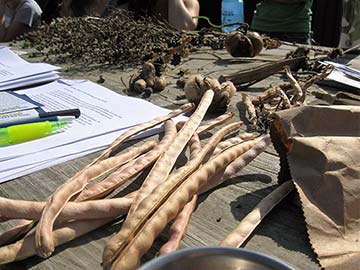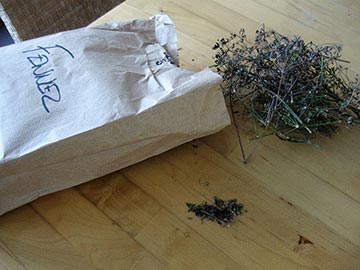
© Kathy Jentz
Fall is the harvest season – not only for those bountiful squashes and apples – but also for the legions of seeds bursting forth on the ornamental and edible plants in your garden.
With seed collecting, timing is everything. You only have a small window of time between the time the seeds form and fall to the ground. If it has rained recently, wait until a few dry days have passed. Then choose a relatively calm (non-windy) day.
Bring your supplies out to the garden with you. They should include a pencil, pruners, and something to put the collected seeds in. Paper envelopes are best as they are the easiest to label while outside, but you can also use small glass jars or plastic baggies with a sheet of sticker labels.

© Kathy Jentz
Label your seeds immediately. Write the date of collection along with the plant name and flower color (if any). Nothing is more frustrating than coming across a bag of seeds months later and having no idea if they are the white or pink hollyhocks you wanted to plant.
Go around your garden and look at the drying flower heads on your annual and perennial flowers as well as on herb plants. Sometimes it is easy to break apart the heads and dump them out in your envelopes right then and there. This works well for many of the annuals like cosmos, zinnias, and sunflowers.
Other times, the seeds are so tiny that to break them apart outside risks losing them all to a light breeze or the flower heads are not dry enough to be ready for releasing their seeds. This happens often for herbs like basil, dill, and bronze fennel. In those cases, take along brown paper lunch bags and snip off the whole flower heads into them. Label the bags and hang them in a dry place such as a screened porch to dry for a week or so. Give the bags a good shaking and the seeds collect at the bottom then carefully pour off the leftover plant parts (chaff), leaving the tiny seeds in the bag or transferring them to a new container.
The next step is to take all the collected seeds and store them in a cool, dry place out of direct sunlight. Be sure the storage spot is rodent-proof as well - an old metal tool box is good for that purpose.
Finally, mark your calendar for early next spring to pull your seeds out and start planning your next garden planting season!